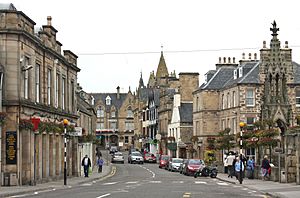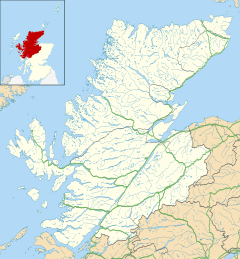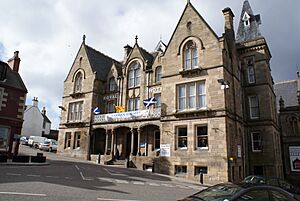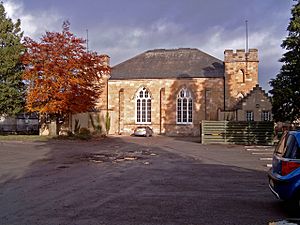Tain facts for kids
Quick facts for kids Tain
|
|
|---|---|
 |
|
| Area | 2.12 km2 (0.82 sq mi) |
| Population | 3,570 (2020) |
| • Density | 1,684/km2 (4,360/sq mi) |
| OS grid reference | NH779821 |
| • Edinburgh | 133 mi (214 km) |
| • London | 463 mi (745 km) |
| Council area | |
| Lieutenancy area | |
| Country | Scotland |
| Sovereign state | United Kingdom |
| Post town | TAIN |
| Postcode district | IV19 |
| Dialling code | 01862 |
| Police | Northern |
| Fire | Highlands and Islands |
| Ambulance | Scottish |
| EU Parliament | Scotland |
| UK Parliament |
|
| Scottish Parliament |
|
Tain is a historic town in the Highlands of Scotland. Its name in Scottish Gaelic is Baile Dhubhthaich. Tain is known for being Scotland's oldest royal burgh, a special type of town with royal approval.
Contents
What Does Tain Mean?
The name Tain comes from the nearby River Tain. The river's name means 'flow'. The Gaelic name, Baile Dhubhthaich, means 'Duthac's town'. This is named after a local saint called Duthus.
A Look Back: Tain's History
Tain received its first special permission, called a royal charter, in 1066. This makes it the oldest royal burgh in Scotland. In 1966, a Rose Garden was opened by Queen Elizabeth, the Queen Mother to celebrate this.
Early Days and Saint Duthac
The 1066 charter was given by King Malcolm III. It made Tain a special place where people could find safety with the church. It also meant that local traders did not have to pay certain taxes.
Tain's importance grew because of Saint Duthac. He was an early Christian figure from around the 8th or 9th century. His shrine became very important by 1066, leading to the royal charter. A ruined chapel near the river's mouth is said to be where he was born.
A Place of Pilgrimage
Duthac became an official saint in 1419. By the late Middle Ages, his shrine was a major place for people to visit on a religious journey, called a pilgrimage. King James IV visited Tain at least once a year. He did this to achieve both spiritual and political goals.
Sanctuary and Conflict
The early Duthac Chapel was the center of a sanctuary. This was a safe area where people seeking protection could go. During the First War of Scottish Independence, Robert the Bruce sent his wife and daughter there for safety. However, they were captured by enemies and handed over to Edward I of England.
Things to See and Do in Tain
Tain has a train station on the Far North Line. It opened in 1864. Today, it is not staffed, but it once had 30 workers.
Important Buildings
You can visit the Tain Tolbooth, which is a historic town hall. There is also the beautiful St Duthus Collegiate Church. If you want to learn about the town's past, check out the local history museum, Tain Through Time. Tain is also home to the Glenmorangie distillery, where whisky is made.
Schools in Tain
Tain has two primary schools: Craighill and Knockbreck. For older students, there is a secondary school called Tain Royal Academy.
RAF Tain: A Wartime Airfield
Before World War II, a large airfield was built near Tain. It was big enough for bombers. During the war, British, Czech, and Polish airmen used it.
After the war, it stopped being used for flying. It was then turned into a bombing range for the navy. Today, parts of the original airfield are open for public use.
Sports and Fun in Tain
Tain Golf Club has a Championship golf course. It was designed by Old Tom Morris in 1890 and looks out over the Dornoch Firth.
The town also has a senior football club, St Duthus Football Club. They play in the North Caledonian Football League.
Exploring the Area Around Tain
The Gizzen Briggs are sandbars at the entrance to the Dornoch Firth. If the wind is right, you can hear them at low tide. There's a famous "million dollar view" to the north-west of Tain. From here, you can see a wide view of the Dornoch Firth and Sutherland.
Nearby Castles
There are five important castles close to Tain:
- Carbisdale Castle: Now a youth hostel.
- Skibo Castle: Once owned by the famous industrialist Andrew Carnegie, now a hotel.
- Dunrobin Castle: The home of the Duke of Sutherland, open to visitors.
- Balnagown Castle: The historic home of the Clan Ross.
- Ballone Castle: Restored by local craft business owners.
You can also find Highland Fine Cheeses, a cheese factory, near Tain. The site of the old Fearn Abbey is just outside Hill of Fearn.
Famous People from Tain
- Saint Duthac (1000–1065): An 11th-century saint.
- Peter Fraser (1884–1950): He was the 24th Prime Minister of New Zealand. He was born near Tain.
- Elizabeth Ness MacBean Ross (1878–1915): A doctor who grew up here and went to Tain Royal Academy.
- Professor Thomas Summers West (1927–2010): A world-famous chemist who went to school at Tain Royal Academy.
Tain's Weather
Tain has an oceanic climate, which means it has mild temperatures and rain throughout the year.
| Climate data for Tain Range (4 m or 13 ft asl, averages 1991–2020) | |||||||||||||
|---|---|---|---|---|---|---|---|---|---|---|---|---|---|
| Month | Jan | Feb | Mar | Apr | May | Jun | Jul | Aug | Sep | Oct | Nov | Dec | Year |
| Mean daily maximum °C (°F) | 6.6 (43.9) |
7.4 (45.3) |
9.3 (48.7) |
11.6 (52.9) |
14.0 (57.2) |
16.4 (61.5) |
18.4 (65.1) |
18.2 (64.8) |
16.3 (61.3) |
12.7 (54.9) |
9.2 (48.6) |
6.7 (44.1) |
12.2 (54.0) |
| Mean daily minimum °C (°F) | 0.4 (32.7) |
0.5 (32.9) |
1.8 (35.2) |
3.4 (38.1) |
5.5 (41.9) |
8.7 (47.7) |
10.5 (50.9) |
10.2 (50.4) |
8.2 (46.8) |
5.3 (41.5) |
2.4 (36.3) |
0.2 (32.4) |
4.8 (40.6) |
| Average rainfall mm (inches) | 57.8 (2.28) |
51.0 (2.01) |
46.1 (1.81) |
42.5 (1.67) |
51.4 (2.02) |
52.9 (2.08) |
56.7 (2.23) |
57.9 (2.28) |
52.8 (2.08) |
72.6 (2.86) |
59.7 (2.35) |
58.7 (2.31) |
660.1 (25.98) |
| Average rainy days (≥ 1 mm) | 12.6 | 11.8 | 11.5 | 10.0 | 11.5 | 11.0 | 11.7 | 11.3 | 10.4 | 13.3 | 13.0 | 13.2 | 141.3 |
| Source: Met Office | |||||||||||||
Freedom of the Royal Burgh
Some people and military groups have been given the special honour of "Freedom of the Royal Burgh" of Tain. This is a way for the town to show great respect.
Individuals Honoured
- Sir Arthur Bignold: 1907.
- Colonel James Alexander Francis Humberston Stewart Mackenzie of Seaforth: 1907.
- Sir John Fraser: 1925.
See also
 In Spanish: Tain para niños
In Spanish: Tain para niños






